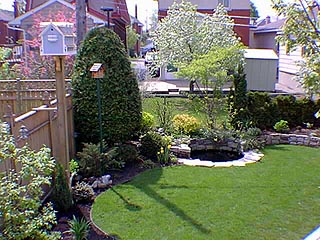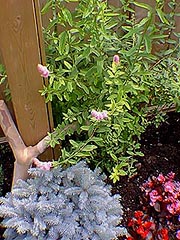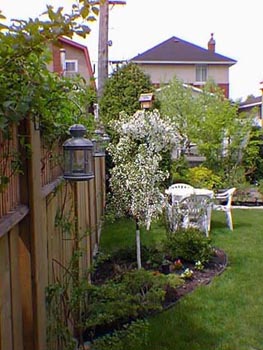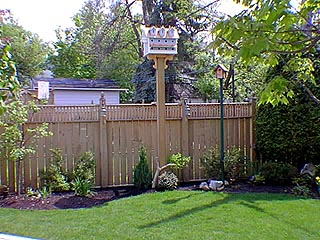| You can tell, if you have an area of the garden that still needs to be developed, especially if you are an equally avid photographer of your garden. You search through hundreds of images and come up with one rather poor "before" shot! (We see what we want to see, right?)
We had been staring at one small area for a number of years talking about another water feature, a stone & thyme patio area for table and chairs, or perhaps one more flower bed...
Garry's "it's February and if I don't do something, I'll go insane..." winter
98 project rather bountifully provided the answer. The summer before
we had had our first swallows in the backyard, enjoyed them thoroughly
and wanted to encourage more. The internet search for the ideal
swallow house complete, Garry set about building an 18 unit Victorian
'folly-in-the-air', including two Juliet balconies for feathered
Romeos! |
 |
|
The structure ended up being 24" long, 16" wide and 26" high, with full-length front and back 'porches'; two end balconies and six gables.
The roof is detachable (with hasps and pins) and the interior sixteen unit section is constructed with a thin plywood freestanding removable honeycomb to allow for cleaning. The gable roof is actually just two units, accessible from the ends All units are provided with cross-ventilation.
|
|
Each unit is roughly 8" high, 4" wide and 8" deep, which is fairly close to the size recommended.
|
 The location was actually the most ideal in our backyard for the
placement of a swallow condo - the furthest from the existing tall
trees.We decided to leave the single birdhouse which had originally
attracted the swallow pair.
The location was actually the most ideal in our backyard for the
placement of a swallow condo - the furthest from the existing tall
trees.We decided to leave the single birdhouse which had originally
attracted the swallow pair.
All the information assured us that the pair would return to the same place they had previously nested.
|
|
And they did. Unfortunately, we should have blocked up the holes an incredibly aggressive sparrow had moved a harem of female sparrows into the units, and a second pair had occupied the original single birdhouse. |
|

They won the battle with the swallows, and the din they created
was second only to the noise which ensued when the chicks hatched.
It was close to deafening, moving us out of the back yards for
a week or two. And there were so many little birds flopping around on the
|
|
ground while learning to fly, our cats had their access restricted too!. What's that line about "too much of a good thing"? Be forewarned!
O well, at least it gave us an excuse to add another ten feet of planting beds! And by doing so, to significantly expand the apparent size of the garden as a whole. The new garden blocked visual access to the fence, blurring the "edge" of the garden, and giving a much more lush feel to that area of our small urban garden.
|
 |
|
We integrated the the two existing beds largely through colour, echoing the now 12' blue spruce in the corner behind the pond with a miniature globe blue spruce, and where we wanted height, an Ontario Green juniper, which is similar in colour to the existing yews. We tied into existing spireas in both the pond and gate beds with a medium growing Triumphan's Spirea.
We also took suckers from the American Bittersweet to start two new plants behind the birdhouse pole, eventually to cover the rest of the fence as well as climb up the bird pole. A third day lily was moved from a less ideal location, and the remainder of the bed was filled in with annuals for the first growing season - few of which we shall need in future years, given our record of over-planting!
But the most rewarding result was an entirely new view to contemplate in the summer sun! - which if we gardeners would admit it, is the main reason we always find some plant that's " not in the ideal growing location"!
|
|

